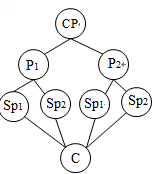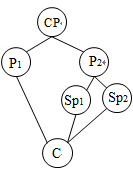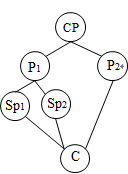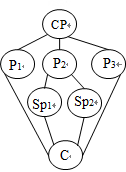When scholars of international relations predict that the 21st century will be a “Chinese century”, they are full of reasons.
China’s amazing
Silk was not the only product to be transported along the Silk Road,
Rather than traveling the entire length of the Silk Road, each merchant traded goods along one section of the route,
Silk Road trades traveled together in long caravans (旅行队) of camels. This mode of travel provided
3 . The poverty line is the minimum income that people need for an acceptable standard of living. People with incomes below the poverty line are considered poor. Economists study the causes of poverty in order to find solutions to the problem.
As the general standard of living in the country rises, the poverty line does, too. Therefore, even with today’s relatively high standard of living, about 10 percent of the people in the United States are below the poverty line. However, if these people had stable jobs, they could have an acceptable standard of living. Economists suggest several reasons why poor people do not have jobs.
For one thing, more than half of the poor people in the United States are not qualified to work. Over 40 percent of the poor people are children. By law, children less than 16 years old cannot work in many industries. A large number of poor people are old. Many companies do not hire people over 65 years old, the normal retirement age.
Some poor adults do not look for jobs for a variety of personal reasons: they are sick, they do not have any motivation, they have family problems, or they do not believe that they can find a job.
Other poor people look for a job, but cannot find one. Many poor adults never went to high school. Therefore, when they look for jobs, they have few skills that they can offer.
At the present time, the government thinks it can reduce poverty in the country in the following ways:
First, if the national economy grows, businesses and industries hire more workers. Some of the poor who are qualified to look for jobs may find employment. Then they will no longer below the poverty line.
Second, if society invests in the poor, the poor will become more productive.
If the government spends money on social programs, education and training for poor people, the poor will have the skills to offer. Then it is more probable that they can find jobs.
Finally, if the government distributes society’s income differently, it raises some poor people above the poverty line. The government collects taxes from the non-poor and gives money to the poor. These payments to the poor are called welfare.
Some economists are looking for better solutions to the poverty problem. However, at the present time, many people depend on welfare for a minimally acceptable standard of living.
1. This passage is mainly about ________.| A.the poverty line |
| B.how to look for jobs |
| C.how to raise the standard of living |
| D.the causes of poverty and solutions to the problem |
| A.falls | B.does not change |
| C.rises | D.changes at random |
| A.They are too sick to work. | B.They have no motivation. |
| C.They family problems. | D.They are too lazy to find jobs. |
| A.charge | B.share |
| C.receive | D.deliver |
4 . The future of Australia’s solar industry is looking bright after a record 3.5m panels(嵌板)were installed on rooftops last year, giving the equal output of a medium-sized coal-fired power station. The record 1,057 MW of capacity (产能) in small scale systems installed across the country broke the previous record set in 2012, figures from the Clean Energy Regulator showed on Tuesday.
Australia’s solar power prosperity could almost double capacity in a year, The data also revealed that the average system size has also doubled since then from three to six kilowatts as average prices continued to fall. A fully installed 5KW system costs an average of $5,930 in Australia, according to the energy broker Solar choice. net. au. Its records show that the price has roughly halved in many capital cities since 2012.
The regulator’s executive general manager, Mark Williamson, said there was increasing interest in renewals as a way to take control of electricity bills. But more importantly, he said it was also good news for reducing carbon emissions,
“We are seeing a wide cross section of Australians—households, community centers, schools, and small businesses—receiving rewards under the small scale renewable energy scheme,” Williamson said, “Our data shows consumers are embracing renewable energy to take control of their electricity bills. ”
In 2017, there was a 41% increase in installing renewable energy capacity across all states and territories compared to 2016. Queensland led the way with installed capacity at 295MW, with the Australian Capital Territory taking top place for the biggest annual increase by 57 %. “I he data collected by the Clean Energy Regulator in 2017 reflects the industry is going from strength to strength, It looks like 2018 will be another big year for the solar industry.”
The total of installed capacity for last year is expected to rise to 1,070MW when all the data is collected. A large coal-fired power station such as Loyd Yang A in Victoria’s Latrobe Valley has a capacity of 2, 200MW.
1. What do we know about the Australia’s solar industry from the first paragraph?| A.It’s still risky. |
| B.It’s promising. |
| C.It’s unpredictable. |
| D.It’s within expectation. |
| A.The continuous fall of average price of installing a solar energy system. |
| B.The entire decrease of the carbon emissions. |
| C.The autonomous control of the electricity bills. |
| D.The doubt about the capacity of coal-fired power station. |
| A.Australia’s solar industry is being accepted. |
| B.Australia’s solar industry is developing rapidly. |
| C.Australia’s solar industry is more practical than before. |
| D.Australia’s solar industry is more advanced than other countries. |
| A.Reducing pollution. |
| B.Providing enough energy. |
| C.Lowering electricity bills. |
| D.Simplifying installed equipment. |
5 . There is no doubt eCommerce is growing, and it will continue to grow. However, physical stores would not die as a result of the rise of eCommerce, at least not in the near future. The idea that eCommerce is taking over physical stores has already misguided many people. Physical stores are far from vanishing, and there are some solid reasons for it.
The projections for online spending is optimistic with $150 billion expected to be spent in the coming three years, yet we are also expecting $300 billion in spending at physical stores in the same duration. Do you still think that physical-store shopping is too small to sustain the eCommerce blow?
Even though consumers are staying away from physical stores that follow older concepts, yet we are seeing the rise of fresh concept stores all around the US. We are seeing innovative and attractive success stories of physical stores, ranging from clothes stores to restaurants to health spas. It would be easy to assume that this trend will continue.
Indeed, many shopping malls are dying, yet there are still those shopping centers that are performing well. You can see this for yourself by visiting shopping malls near you. What I want to emphasize here is that not all shopping centers are made equal, just like not all eCommerce retailers are made equal. Both shopping malls and eCommerce sites can lose business if they fail to maintain productivity through improvements and innovations. When you visit shopping centers that are serious about their business, you would see their shops and parking lots packed.
On the other hand, even e-tailers like Amazon have experimented with pop-up shopping concepts. It is important to bear in mind that consumers prefer face-to-face interactions instead of online interactions during shopping, meaning that physical stores are going to stay there.
Still, eCommerce retailers are seeing all of their excitement disappear as they settle the sales tax problem associated with e-tailing. As of now, five states of America have already imposed sales tax on purchases through eCommerce sites, and e-tailers in those states have already witnessed 6 to 12 percent decrease in sales.
This reinforces the fact that physical stores are here to stay, and if you are still undervaluing their growth, you are omitting a huge chunk of the retail representation.
1. The underlined word "projections" in Paragraph 2 probably means____.| A.intentions | B.assessments |
| C.performances | D.predictions |
| A.E-tailers are more creative businesses. |
| B.Fresh concepts help build good business. |
| C.Fewer consumers will visit physical stores. |
| D.Physical stores can’t stand the blow of eCommerce. |
| A.Is Offline Spending Greater Than Online Spending? |
| B.Online Stores V.S. Physical Stores — What’s the Difference? |
| C.Will Physical Stores replace eCommerce in the Near Future? |
| D.Does eCommerce Success Mean Physical Stores Will Disappear? |
CP: Central Point P: Point Sp: Sub-point (次要点) C: Conclusion
A. | B. |
C. | D. |
According to the World Bank, one of its chief supporters, economic globalization has helped reduce
Those who
Critics take a different view, believing that economic globalization is actually
One thing is certain about globalization—there is no
| A.possible | B.smooth | C.good | D.easy |
| A.crime | B.poverty | C.conflict | D.population |
| A.contributing | B.responding | C.turning | D.owing |
| A.remain | B.drop | C.shift | D.increase |
| A.doubt | B.define | C.advocate | D.ignore |
| A.In addition | B.For instance | C.In other words | D.All in all |
| A.mature | B.new | C.local | D.foreign |
| A.finding | B.exploring | C.bridging | D.widening |
| A.suffered | B.profited | C.learned | D.withdrawn |
| A.Furthermore | B.Therefore | C.However | D.Otherwise |
| A.consume | B.deliver | C.export | D.advertise |
| A.trouble | B.business | C.power | D.mind |
| A.keep up | B.come in | C.go around | D.help out |
| A.taking off | B.getting along | C.holding out | D.turning back |
| A.agreement | B.prediction | C.outcome | D.challenge |
In the 19th and early 20th centuries, many people viewed cities negatively — crowded, dirty environments full of disease and crime. They feared that as cities got bigger, living conditions would worsen. In recent decades, however, attitudes have changed. Many experts now think urbanization (城市化) is good news, offering solutions to the problems of Earth’s growing population.
Harvard economist Edward Glaeser, author of The Victory of the Cir, is one such person. Glaeser argues that cities are very productive because “the absence of space between people” reduces the cost of transporting goods, people, and ideas. While the flow of goods has always been important to cities, what is most important today is the flow of ideas. Successful cities enable people to learn from each other easily, and attract and reward smart people with higher wages.
Another urbanization supporter is environmentalist Stewart Brand. Brand believes cities help the environment because they allow haft of the world’s population to live on about four percent of the land. This leaves more space for open country, such as farmland. City dwellers also have less impact per person on the environment than people in the countryside. Their roads, sewers, and power lines need fewer resources to build and operate. City apartments require less energy to heat, cool, and light. Most importantly, people in cities drive less so they produce fewer greenhouse gases per person.
So it’s a mistake to see urbanization as evil; it’s a natural part of development. The challenge is how to manage the growth.
1. What is Paragraph 1 mainly about?
| A.The history of modern cities. |
| B.Changes taking place within cities. |
| C.How cities have grown over time. |
| D.Why modern cities are changing. |
| A.They now view the weaknesses as strengths. |
| B.They no longer see city-riving as attractive. |
| C.They accept city life in spite of its problems. |
| D.They think city-riving provides more benefits. |
| A.Cities provide more economic opportunities. |
| B.City people get along better with each other. |
| C.Over-crowded cities result in problems. |
| D.Cities limit the flow of ideas. |
| A.Economic production would be reduced. |
| B.There would be less farmland available. |
| C.People would travel less frequently. |
| D.House values would fall greatly. |
| A.That kept cities very small. |
| B.The rest live in small towns. |
| C.The effects of urban living on people should be considered. |
| D.Soon many other industrial nations became urban societies. |
| E.But even 200 years ago, only a few people could live in cities. |
| F.Modernization drew people to the cities and made farmers more productive. |
| G.Modern cities have destroyed social relations and the health of human beings. |
In the early 17thcentury, the idea of the “Grand Tour” was born. Rich young English people sailed across the English Channel(英吉利海峡). They visited the most beautiful and important European cities of the time, including Paris in France, and Rome and Venice in Italy. Their tours lasted for two to four years, and the tourists stayed a few weeks or months in each city. The “Grand Tour” was an important part of young people’s education—but only for the rich.
In the 18thcentury, tourism began to change. For example, people in the UK started to visit some towns, such as Bath to “take the waters”. They believed that the water there was good for their health. So large and expensive hotels were built in these towns.
In the 19th century, travel became much more popular and faster. When the first railways were built in the 1820s, it was easier for people to travel towns, so they started to go for holidays by the sea. And some started to have holidays in the countryside as cities became larger, noisier and dirtier.
Traveling by sea also became faster and safer when the first steamships were built. People began to travel more to faraway countries.
The 20th century saw cars become more and more popular among ordinary people. Planes were made larger, so ticket prices dropped and more people used them.
Thus tourism grew. In 1949, Russian journalist Vladimir Raitz started a company called Horizon Holidays. The company organizes everything—plane tickets, hotel rooms, even food—and tourists pay for it all before they leave home. The package tour and modern tourist industry was born.
The first travel agency in China was set up as early as 1949. But tourism did not take off until 1978. In 2002, the industry was 500 billion yuan and became an important part of China’s social development.
1. In the early times, the travelers ________.
| A.all came from Roman | B.were very young and strong |
| C.had lots of money | D.traveled by boat |
| A.It was a long journey. | B.The young men learned a lot from it. |
| C.Those who took the tour weren’t rich. | D.Most of its destinations were in Europe. |
| A.Education | B.Money | C.Transportation | D.People’s ideas |
| A.in 1949 | B.in Roman times | C.in the early 17thcentury | D.in the early 19thcentury |
| A.a plane rising into the air | B.develop very fast |
| C.remove hats and clothes | D.bring down the prices |



